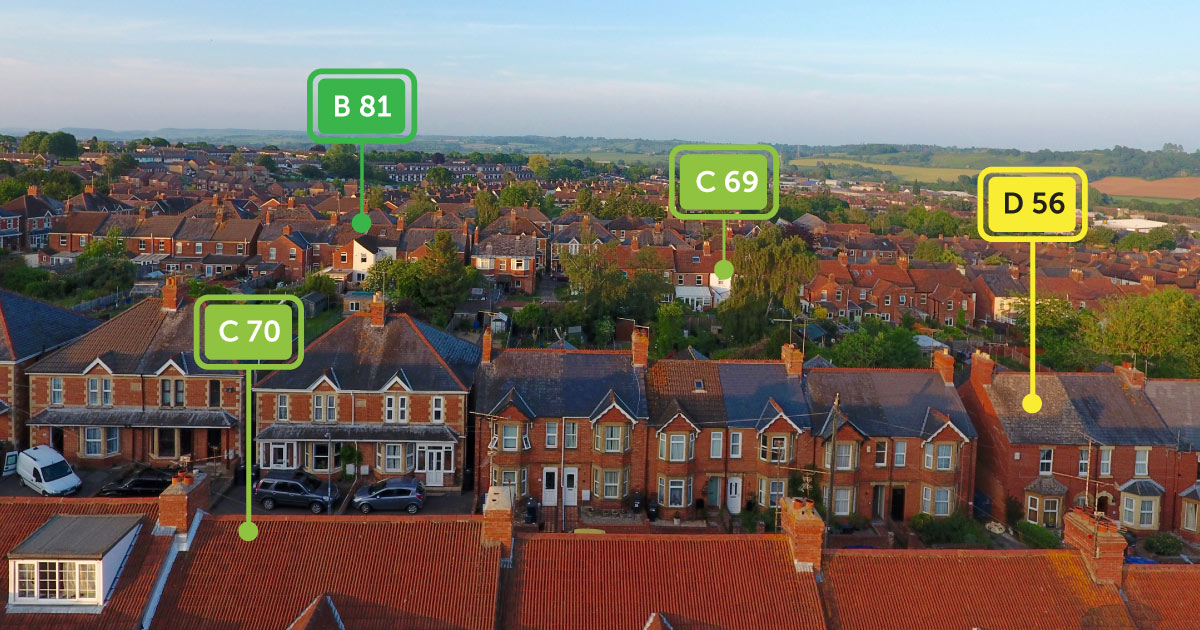New data from the Office for National Statistics shows energy efficiency of homes improving
New figures from the Office for National Statistics (ONS) show that homes in England and Wales are gradually becoming more energy efficient – but the picture is far from even across the country. The latest Energy efficiency of housing in England and Wales: 2025 release, based on Energy Performance Certificate (EPC) data from 2015 to 2025, reveals that the typical home now achieves an EPC Band C, with newer properties performing markedly better than older stock.
The National picture: Typical homes now at Band C
According to the ONS, the median EPC score for homes in England is now 69 – equivalent to Band C – while homes in Wales have a median score of 68, at the top of Band D. London, the East of England and the South East record slightly higher median scores of 70, whereas Yorkshire and The Humber sit at the bottom of the regional table with 68.
Over 65% of local authority areas now have more than half of their housing stock at Band C or better, signalling steady improvement compared to earlier releases. Tower Hamlets leads the way, with 82% of dwellings achieving Band C or above, followed by Knowsley at 74%.
Check the median energy efficiency score in your area by using the map below:
Highlighting the need for effective Retrofit
The ONS data highlights a clear distinction between newer and existing homes, as is clearly expected. Properties built after 2012 in both England and Wales typically achieve a median EPC score of 84, near the top of Band B, while older homes sit significantly lower on the scale.
This underlines a key reality for the housing sector: even though new builds are generally performing well, most of the homes people will live in for decades to come are already built. Real progress will therefore depend on retrofitting these existing properties. Elmhurst members are central to this effort, using EPCs and retrofit assessments in conjunction with our Improvement Evaluator tool to pinpoint practical, cost-effective measures that improve fabric, heating systems and the integration of low-carbon technologies.
Heat pumps and low-carbon heating on the rise
While overall numbers are still relatively small, the role of heat pumps in the housing stock continues to grow. For homes with EPCs, 1.4% of properties in England and 1.5% in Wales now list a heat pump as a source of heating on the certificate. The UK Government has positioned heat pumps as a key part of its wider Net Zero 2050 strategy and introduced support schemes, such as the Boiler Upgrade Scheme (BUS), to encourage their installation.
At a local authority level, Mid-Suffolk in the East of England has the highest proportion of homes with heat pumps (10.6%), followed by Ceredigion in Wales (9.5%). New dwellings are especially likely to feature heat pumps: 4.2% of new homes in England and 5.5% in Wales include a heat pump, compared with under 1% of existing dwellings.
This data is only expected to accelerate as the Future Homes Standard is introduced, which is set to require low-carbon heating in new build homes and effectively end the installation of fossil fuel boilers in new properties. In this context, accurate EPCs and robust heat loss calculations are essential for specifying the right low-carbon system in each home.

Urban vs Rural – Does it make a difference?
The 2025 release introduces new, more detailed analysis of how energy efficiency varies between urban and rural areas. For the first time, the ONS breaks down median EPC scores by settlement type, revealing a clear gap between rural and urban properties. At national level in England, smaller rural areas have a lower median EPC score of 63, compared with 69 for both urban and larger rural areas. In Wales, urban areas score 69 on average, larger rural areas 67, and smaller rural areas just 58.
For existing properties, this gap is even more pronounced. Existing smaller rural homes in England have a median EPC of 59, compared with 68 for urban properties; in Wales the equivalent figures are 55 and 68.
While these averages are useful for spotting broad trends, they also underline a key principle for Elmhurst: every property is different and should be assessed, and improved, on its own merits – with tailored recommendations rather than one-size-fits-all solutions.
How Elmhurst supports better-performing homes
EPCs remain a crucial tool for understanding how homes use energy and where improvements can be made. They help homeowners, landlords and policymakers see not just the current picture, but the practical steps needed to improve comfort, reduce bills and cut carbon. Elmhurst plays a central role in this process by training and accrediting energy assessors to deliver high-quality EPCs and robust retrofit assessments, whilst also supporting our members with ongoing CPD on topics such as low-carbon heating and assessing older, traditional or vulnerable buildings.
Andrew Parkin, Technical Development Director at Elmhurst Energy comments
This ONS data confirms that for the first time, the average rating for dwellings in England is EPC C (69). This comes at a time when the government is set to announce minimum energy efficiency standards of an EPC C for the entire rental sector. Whilst this is slightly lower for Wales, improvement in ratings can be seen in much of England and Wales. The usual regional variations are apparent and in most cases are understandable (rural areas do score lower than more built-up regions), it is interesting to note that rural areas are moving to renewable heat most quickly. This will of course be boosted by the boiler upgrade scheme and Future Homes Standard coming into force soon. What the report also highlights in the vital role of the EPC and of our members in producing the dataset used by this report, but also in retrofit programmes and in the production of Heat Loss Calculations, as we scale up towards ever more efficient dwellings and low carbon heat.

